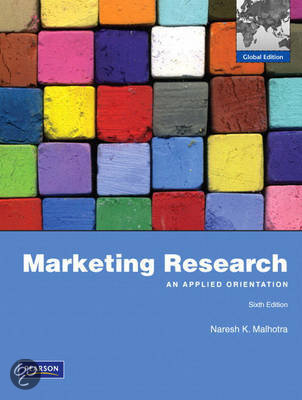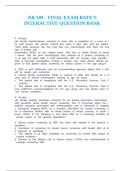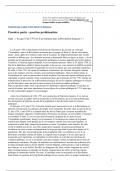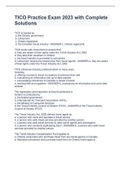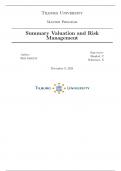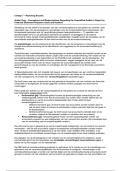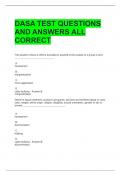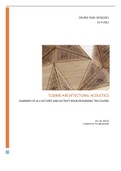MARKETING RESEARCH FOR E&BE
Rijksuniversiteit Groningen
,TABLE OF CONTENTS
1. INTRODUCTIO TO MARKETING RESEARCH ................................................................................................. 3
2. DEFINING THE MARKETING RESEARCH PROBLEM AND DEVELOPING A RESEARCH APPR. .... 5
3. RESEARCH DESIGN ............................................................................................................................................. 10
5. INTERNAL SECONDARY DATA AND THE USE OF DATABASES ............................................................. 16
6. DESCRIPTIVE RESEARCH DESIGN: SURVEY AND OBSERVATION.......................................................... 23
8. MEASUREMENT AND SCALING: FUNDAMENTALS AND COMPARATIVE SCALING ...................... 30
9. MEASUREMENT AND SCALING: NONCOMPARATIVE SCALING TECHNIQUES ............................... 33
10. QUESTIONNAIRE AND FORM DESIGN ......................................................................................................... 38
7. THE MARKETING MIX (Lilien et al) .................................................................................................................... 45
7. CAUSAL RESEARCH DESIGN: EXPERIMENTATION ...................................................................................... 52
21. MULTIDIMENSIONAL SCALING AND CONJOINT ANALYSIS ............................................................... 61
6. NEW PRODUCT AND SERVICE DESIGN (Lilien et al) .................................................................................. 68
3. SEGMENTATION AND TAREGETING (Lilien et al) ........................................................................................ 72
20. CLUSTER ANALYSIS .............................................................................................................................................. 77
4. POSITIONING (Lilien et al) ............................................................................................................................... 82
“Fatigue is the best pillow"
Benjamin Franklin
>>>Visual representation of the quote >> link. Good luck!!!
1
,Literature
– Malhotra, Naresh K.: Marketing Research – An Applied Orientation, 6th edition,
Pearson, 2009. ISBN 978-0136094234
– Lilien, Gary L., Arvind Rangaswamy, and Arnaud De Bruyn: Principles of Marketing
Engineering, 2nd edition, DecisionPro, 2013. ISBN 978-0985764807
Important signs when reading the summary
+ Advantages
– Disadvantages (make sure you distinguish between “-“ and “–“)
Something important to note or to remember
2
, 1. INTRODUCTIO TO MARKETING RESEARCH
In recent years, many factors have increased the need for more accurate and timely information. Because
- As firms become national and international, the need for information on larger, and more
distant, markets has increased.
- As consumers have become more affluent, discerning and sophisticated, marketing managers
need better information on how they will respond to new products and other marketing
offerings.
- As competition has become more intense, managers need information on the effectiveness of
their marketing tools.
- As the environment is changing more rapidly, marketing managers need more timely
information to cope with the impact of changes.
Marketing research –
- ESOMAR: is a key element within the total field of marketing information. It links the consumer,
customer and public to the marketer through information which is used to identify and define
marketing opportunities and problems; to generate, refine and evaluate marketing actions; and
to improve understanding of marketing as a process and of the ways in which specific
marketing activities can be made more effective.
Marketing Research vs. Market Research
- Marketing research: The systematic and objective identification, collection, analysis and
dissemination of information for the purpose of improving decision making related to the
identification of problems and opportunities in marketing.
- Market research: The systematic and objective identification, collection, analysis and
dissemination of information with respect to a particular market, where markets refers to a
specific customer group, competition, or the industry in general.
The marketing research process consists of six broad stages. Each of these stages is developed in more
detail in subsequent chapters; thus, the discussion here is brief.
Stage 1: Problem definition
Trying to understand the nature of the marketing problem that requires
research support.
Stage 2: Research approach development
Involves identifying factors that influence research design. A key element of
this step involves the selection, adaptation and development of an
appropriate theoretical framework to underpin a research design. See chapter
2 for more detail.
Stage 3: Research design developed
A research design is a framework or blueprint for conducting a marketing
research project. It details the procedures necessary for obtaining the required
information.
3
,Stage 4: Fieldwork or data collection
This stage could be simplified to ‘collecting the required data’.
Stage 5: Data preparation and analysis
Data preparation includes the editing, coding, transcription and verification of data.
Stage 6: Report preparation and presentation
The entire project should be documented in a written report
The ESOMAR definition encapsulates two key reasons for undertaking marketing research:
1. To identify opportunities and problems, and
2. to generate and refine marketing actions.
This distinction serves as a basis for classifying marketing research into problem identification research
and problem-solving research:
- Problem identification research: Research undertaken to help identify problems that are not
necessarily apparent on the surface, yet exist or are likely to arise in the future.
o Example: A problem exists if the market potential is increasing but the firm is losing
market share.
- Problem-solving research: Research undertaken to help solve specific marketing problems. In
other words, once a problem or opportunity has been identified, problem-solving research
may be undertaken to help develop a solution.
4
, 2. DEFINING THE MARKETING RESEARCH PROBLEM AND
DEVELOPING A RESEARCH APPR.
Stage 2: Research Stage 5: Data Stage 6: Report
Stage 3: Research Stage 4: Fieldwork
Stage 1: problem definition approach preparation and preparation and
design developed or data collection
developed analysis presentation
Problem definition – A broad statement of the general problem and identifcation of the specific
components of the marketing research problem.
- Most important step
Research brief – A document produced by the users of research findings or the buyers of a piece of
marketing research. The brief is used to communicate the perceived requirements of a marketing research
project.
- Without some formal method of communicating the nature of marketing problem, there is a
great potential for ambiguities, illogical actions, misunderstanding and even forgetfulness.
Components of the marketing research brief:
- Background information: helps the researcher to understand
why certain research objectives are being pursued.
- Objectives:
- Target to research: In this section, details of the characteristics
of the target group(s) can help in many research design
decisions.
- Who is to use findings: This section would outline brief details
of the decision makers who will use the research findings.
Managers, entrepreneurs, etc. use findings differently.
- Constrains: The main limitation to marketing researchers
carrying out what they may perceive being the correct way to
research a problem is the time and money that a marketer
can afford.
- Administration: administrative details in completing the
research project. Examples could be the expected delivery of
interim reports, contacts in an organization.
Research proposal – the official layout of the planned marketing research activity.
- In response to a research brief, the marketing researcher will develop a research plan and will
develop a research proposal to communicate this plan.
- Most proposals address all steps of the marketing research process and contain the elements
shown in the figure below.
5
, 1. Executive summary: overview of the entire proposal.
2. Background: other potential causes of the problems faces or
alternative interpretations (than those presented in the research brief)
of the factors that shape the background in an environmental context
should be presented.
3. Problem definition: again, if necessary, the researcher may go beyond
the problem definition presented in the brief.
4. Research objectives: may be presented in the form of clear
hypotheses that may be tested.
5. Research design: includes the methods of collecting the desired data,
justification of these methods, and a sampling plan to include details
of sample sizes.
6. Fieldwork/data collection: the proposal should discuss how the data
will be collected and who will collect them.
7. Data analysis: This should describe the kind of data analysis that will
be conducted.
8. Reporting: the proposal should state what the form of the final report
be, and whether an oral presentation of the results will be given.
9. Cost and timetable: the cost of the project and a time schedule,
broken down by phases, should be presented.
10. Research organization & researchers: when an organization is working
with researchers for the first time, some idea of past research projects
and clients should be displayed. This can help the marketer to trust
the researcher.
11. Appendices: any statistical or other information of interest to only a few people should be
contained in appendices.
12. Agreement: all parties concerned with fulfilling the research plan should sign and date their
agreement to the proposal.
Preparing a research proposal has several advantages. It ensures that the researcher and management
agree about the nature of the project, and it helps sell the project to a wider array of decision-makers who
may contribute to and benefit from the research findings.
The research brief and the research proposal are the formal documents that ensure each party is clear
about the nature and scope of the research task.
The detail of defining the nature of problems and developing an appropriate research approach to the
point of creating a research design is shown in Figure 2.3.
6
, ENVIRONMENTAL CONTEXT OF THE
PROBLEM
The purpose is to develop an understanding of
forces that may affect the nature of decision-
makers’ problems.
Discussion with decision-makers
Discussions beyond the formal presentation of a
research brief and research proposal such as
“problem audit”. The decision-maker needs to
understand the capabilities and limitations of
research. Conversely, the researcher needs to
understand the nature of the decision that
managers face.
Problem audit – a comprehensive examination
of marketing problem to understand its origin
and nature.
It may be necessary to perform problem audit, because the decision-maker may have only a vague idea of
what the problem is. For example, the decision-maker may know that the firm is losing market share but
may not know why; decision-makers may tend to focus on symptoms rather than on causes. The
researcher should treat the underlying causes, not merely address the symptoms.
The interaction between the decision-maker and the researcher can be characterized by the following:
- Communication
- Cooperation
- Confidence (mutual trust)
- Candour - no hidden agendas and prevail attitude of openness
- Closeness - understanding of each other’s problems should result in closeness
- Continuity – continuous interaction
- Creativity – real life requires creativity and does the research process
Interviews with industry experts
These experts can be found both inside and outside the company. Typically, expert information is
obtained by unstructured personal interviews.
The purpose is to explore ideas, make new connections between ideas, and create new perspectives in
defining the marketing research problem.
Advantages - Experts may have other contacts and/or secondary data that the researcher may not be
aware of.
Disadvantages – some experts may not possess expertise as they claim and it is difficult to obtain help
from experts who are outside the client organization.
Initial secondary data analysis (addresses in chapters 4 & 5)
7


